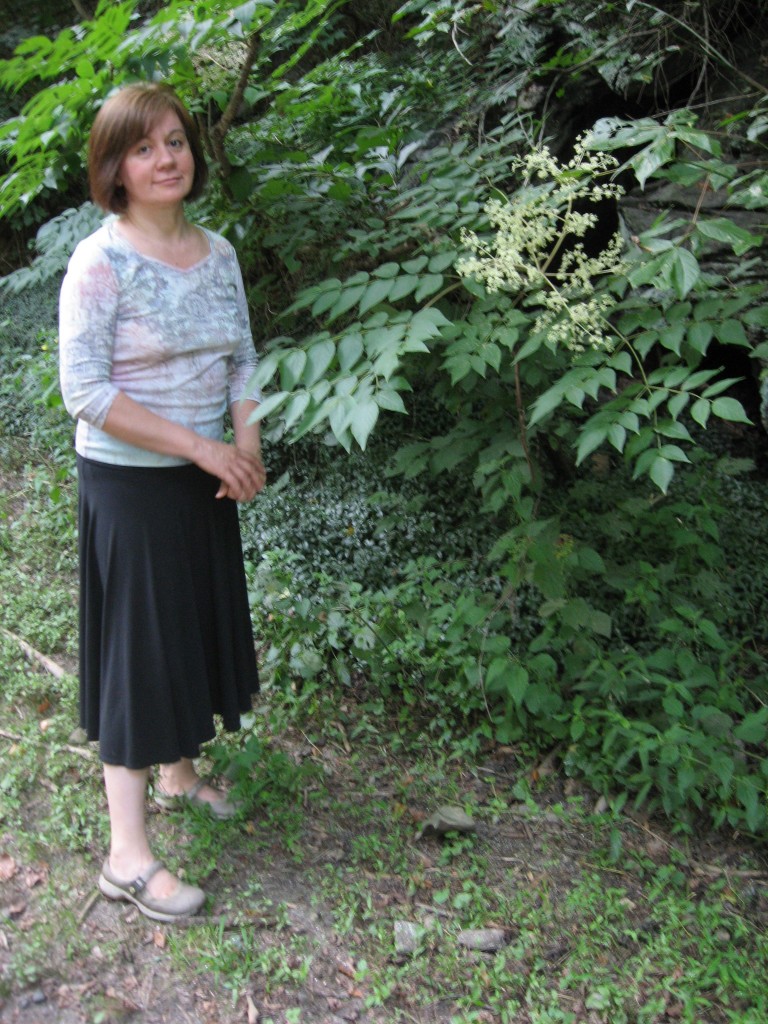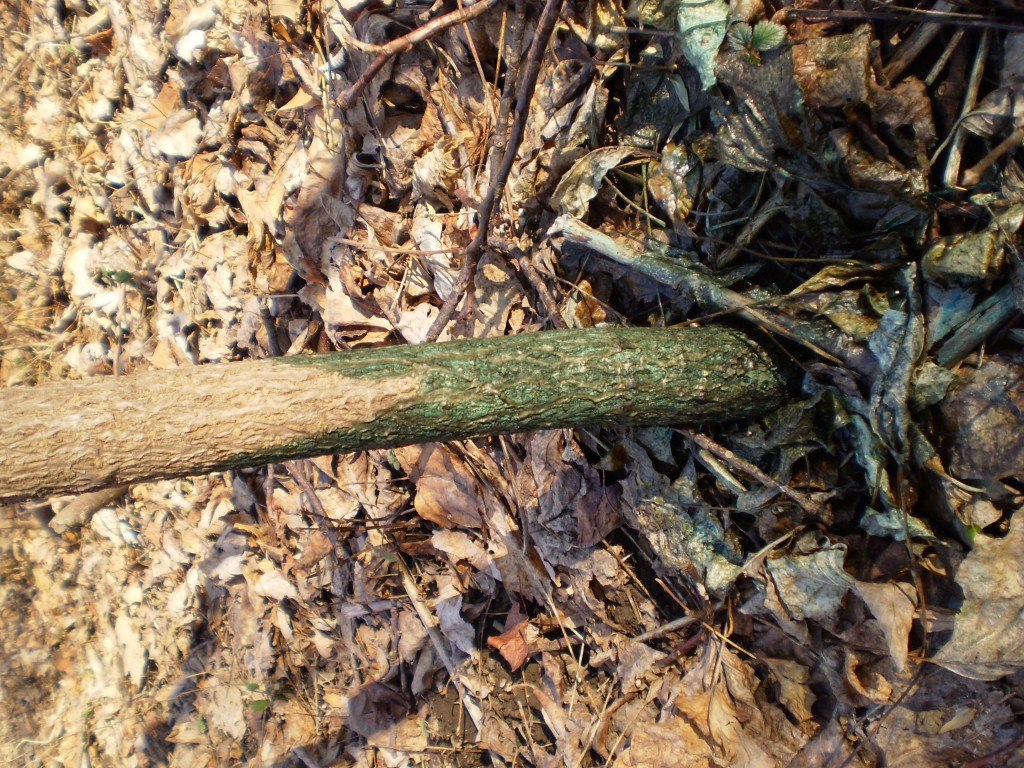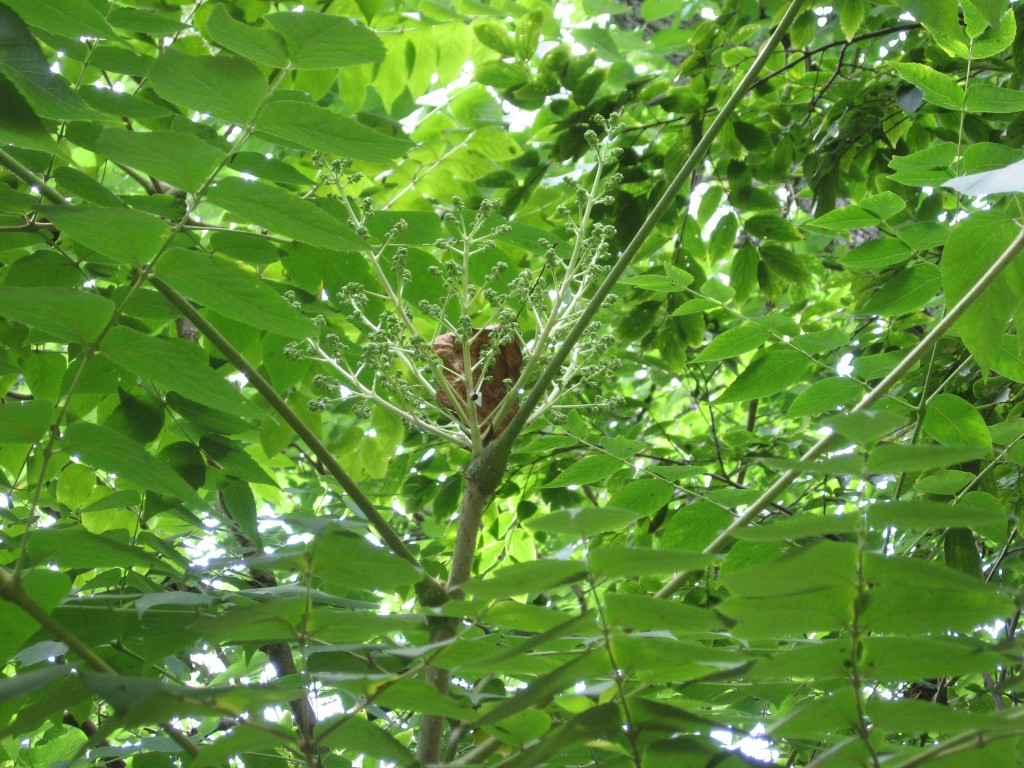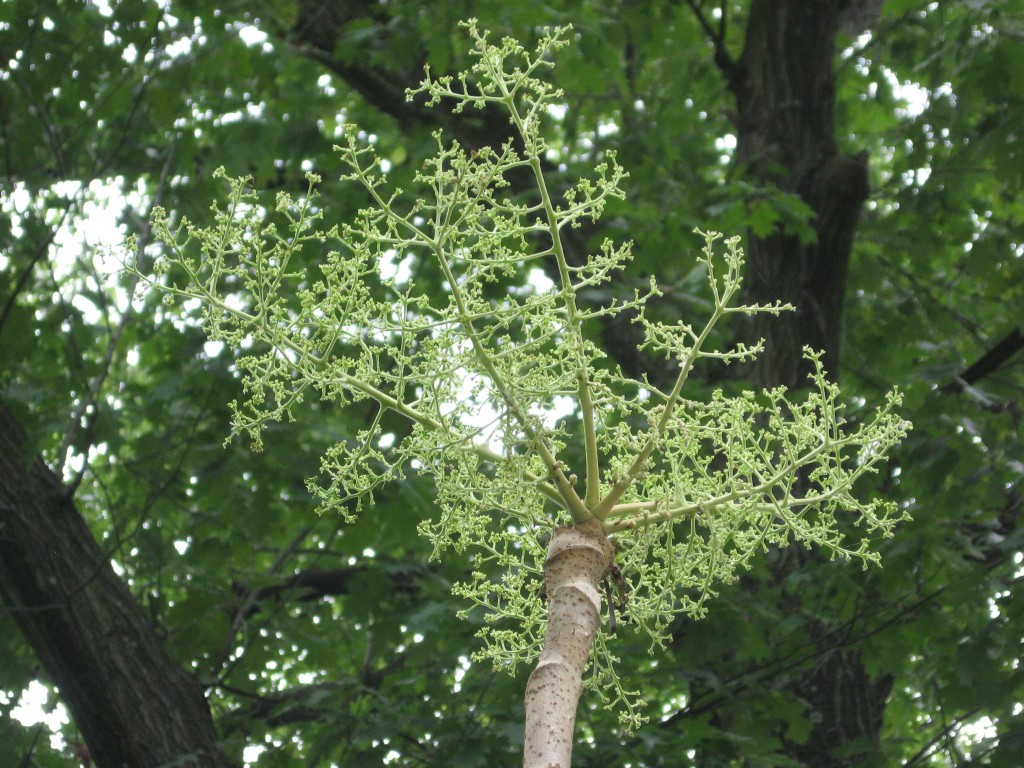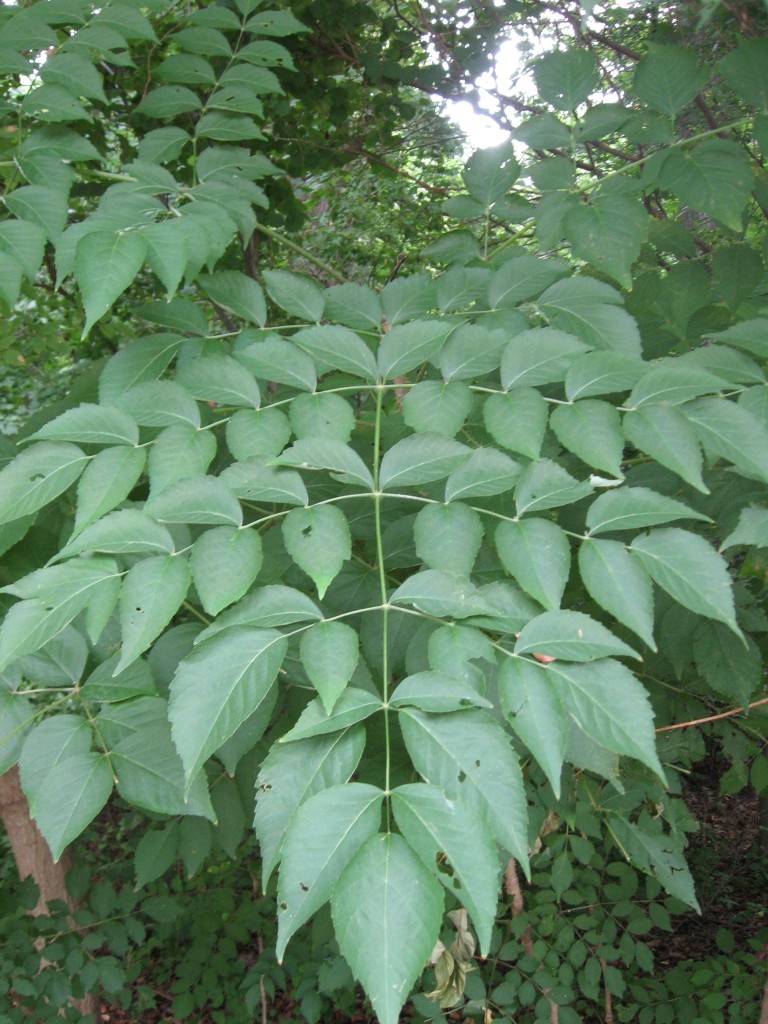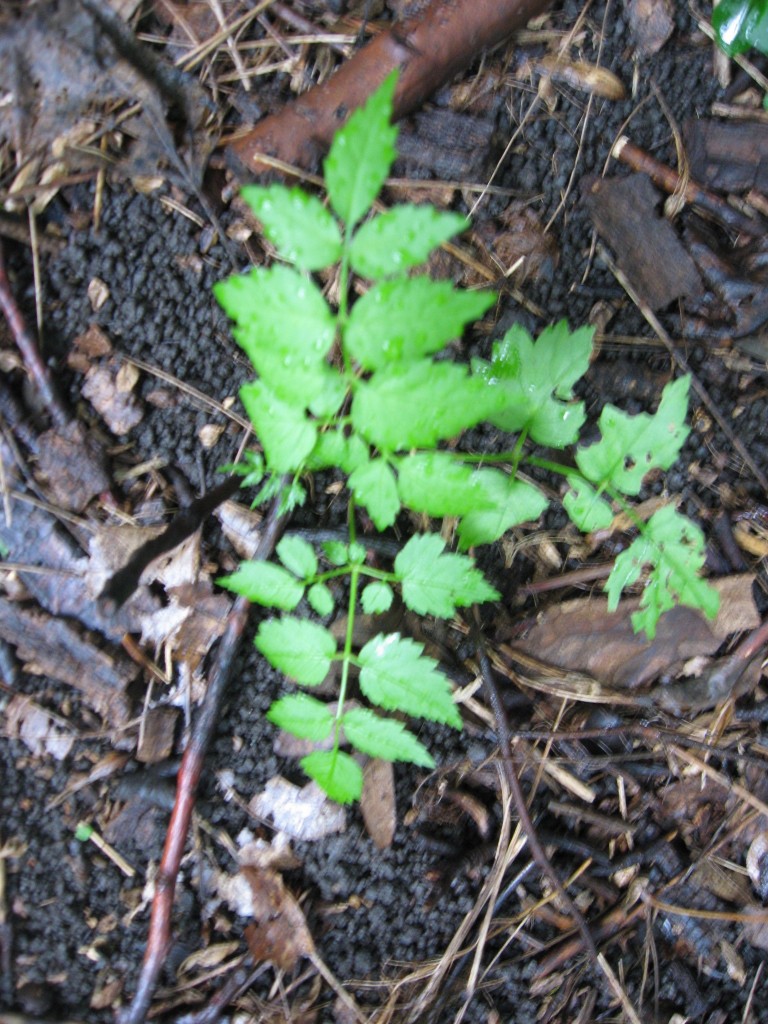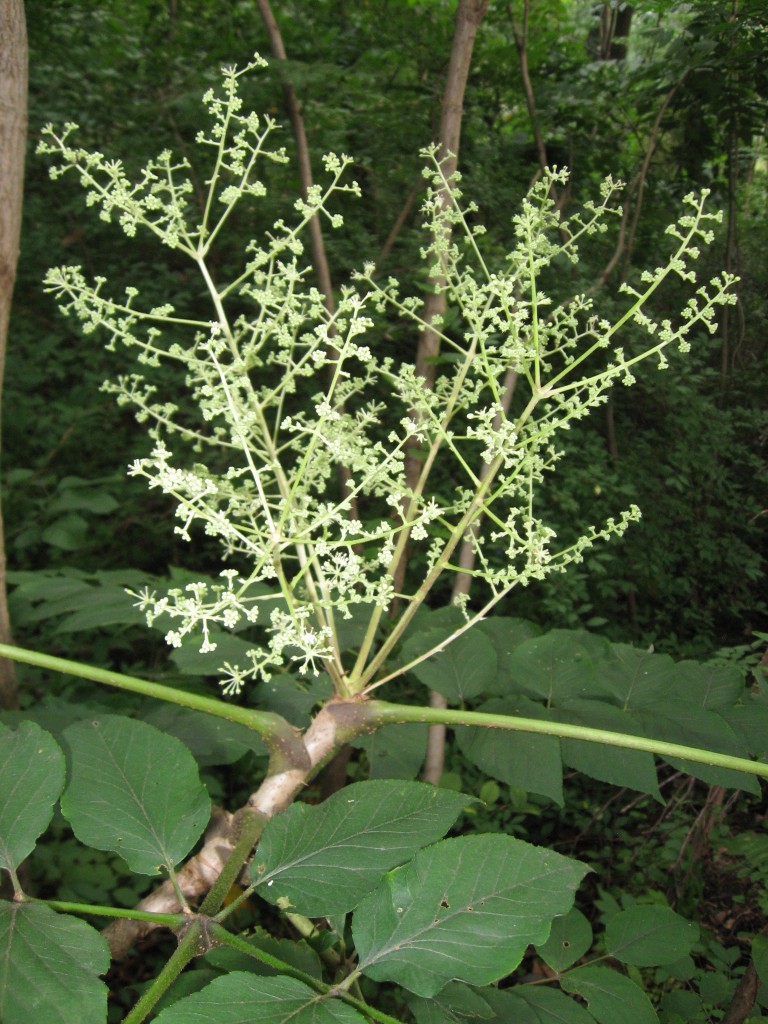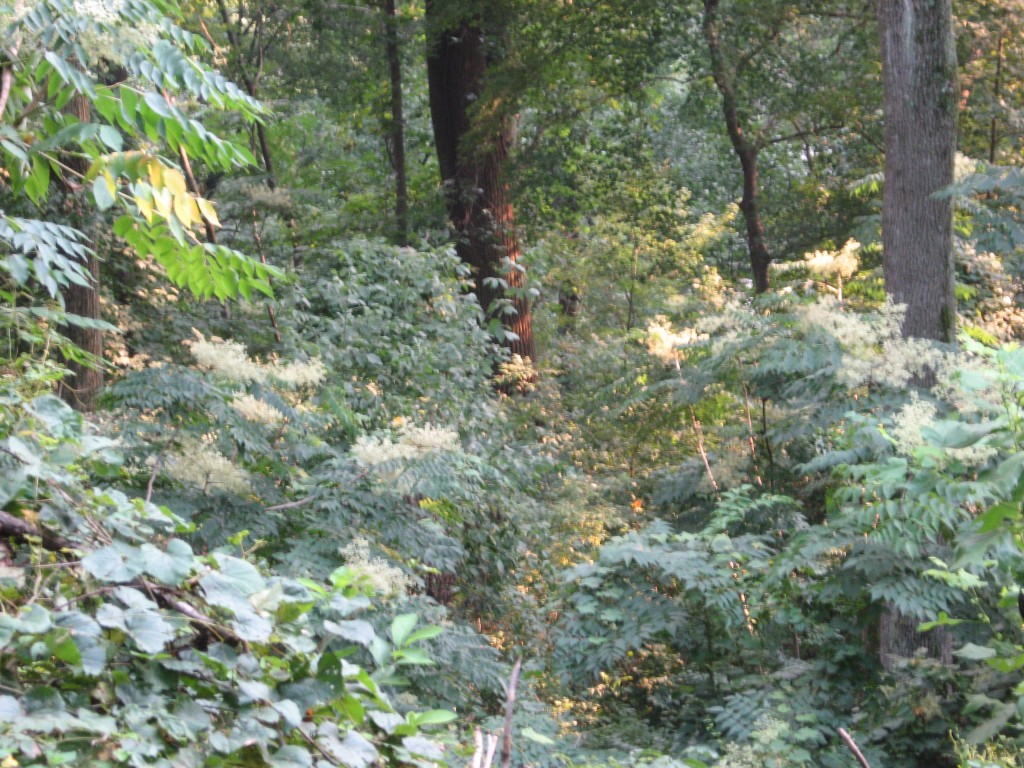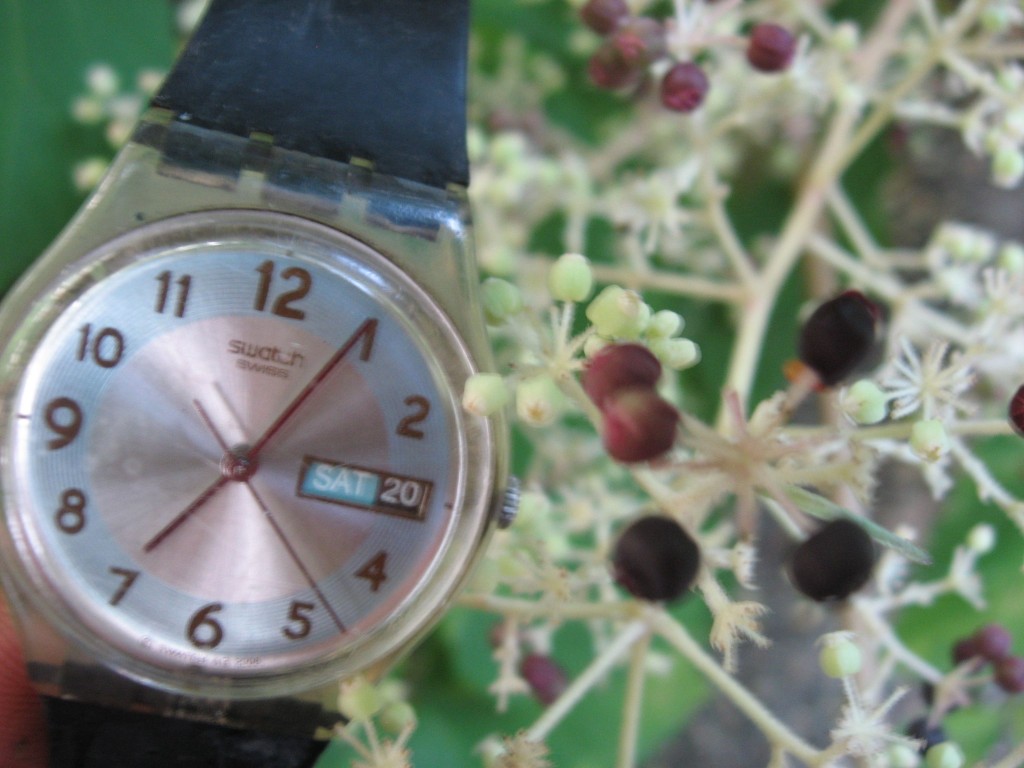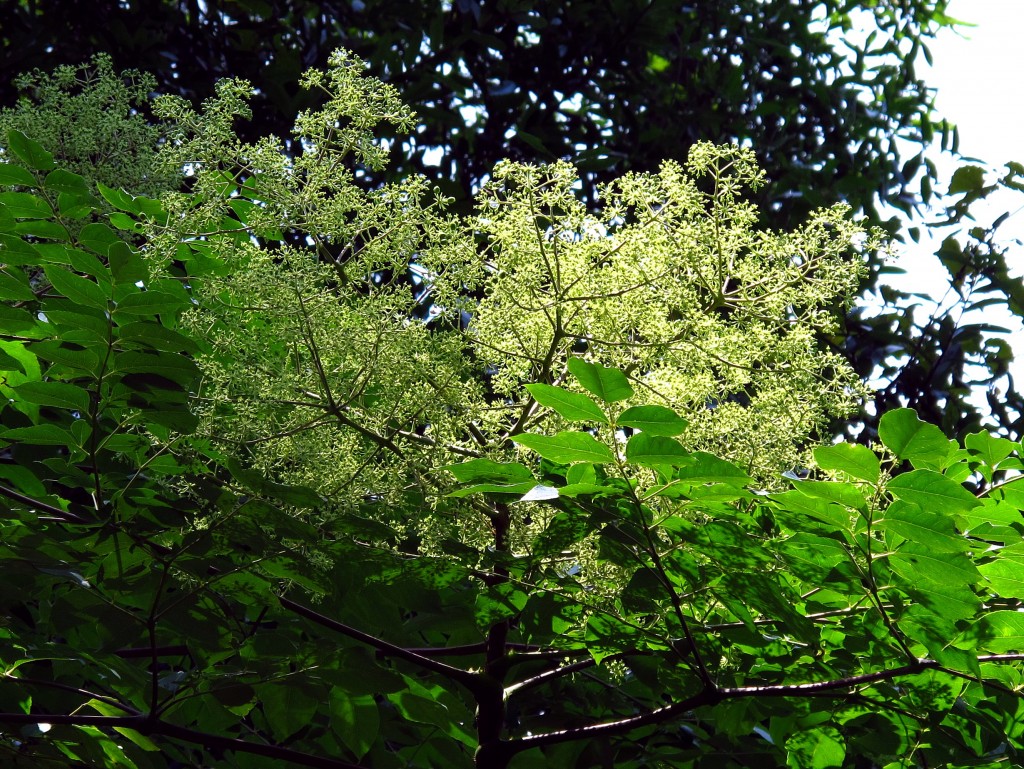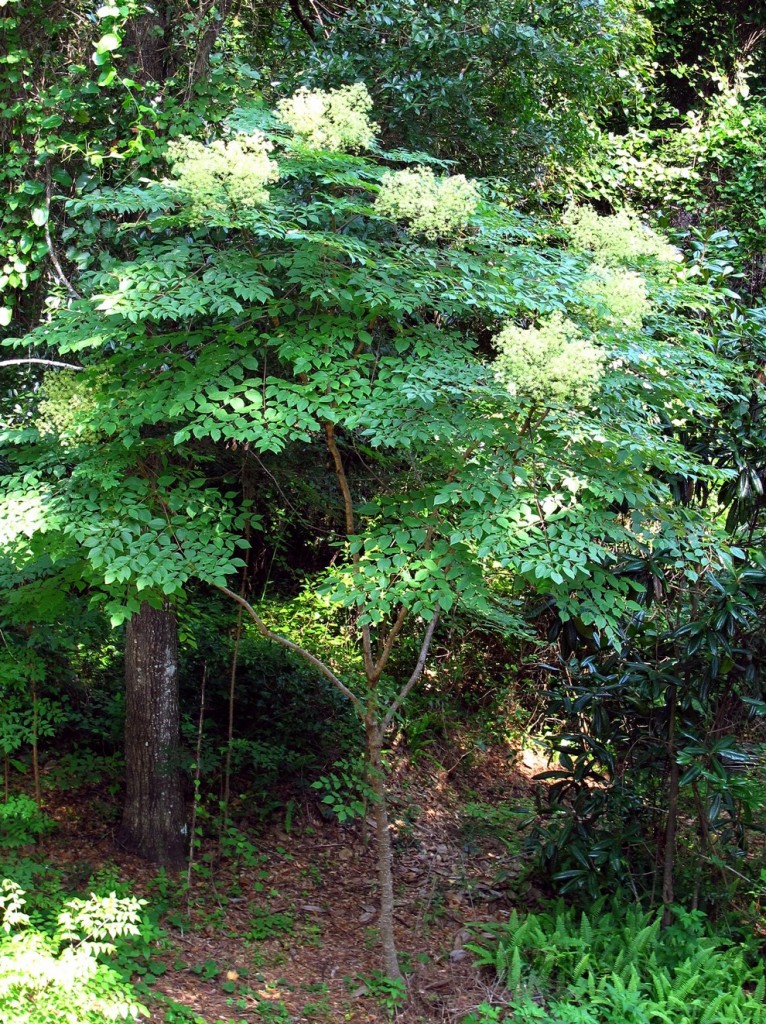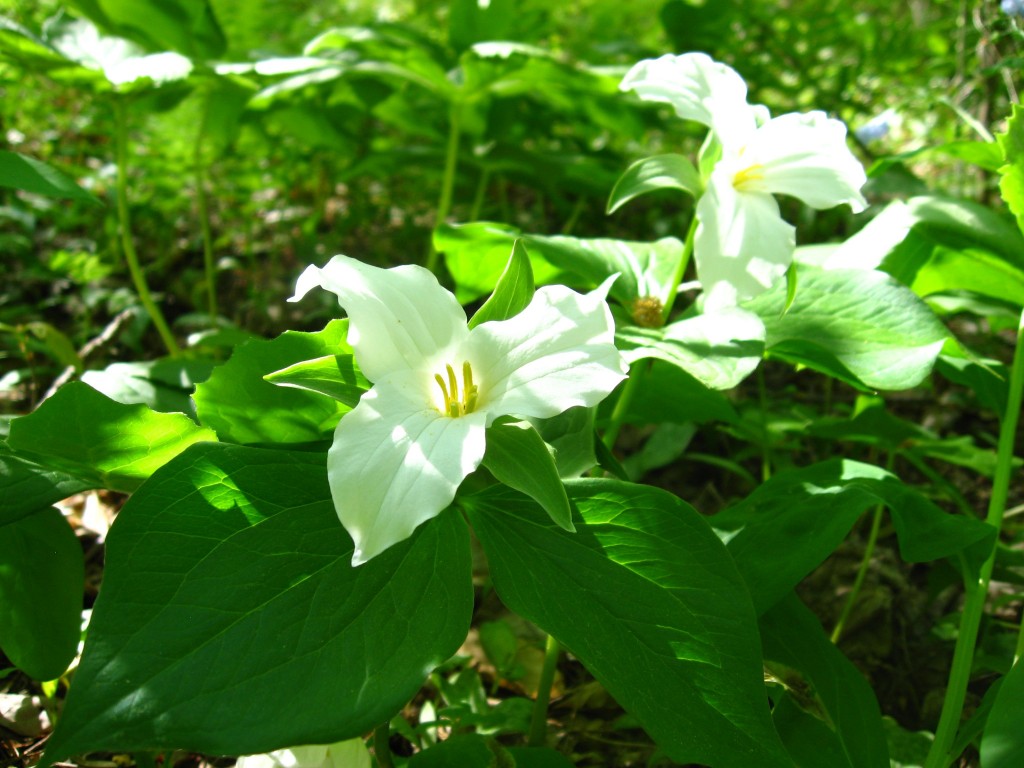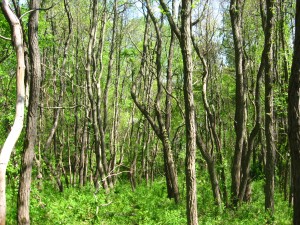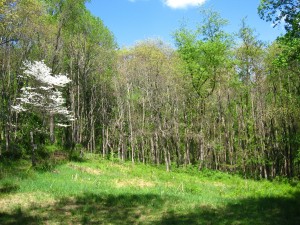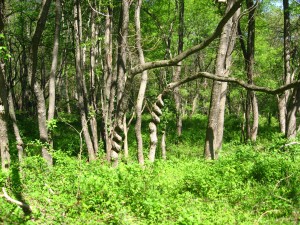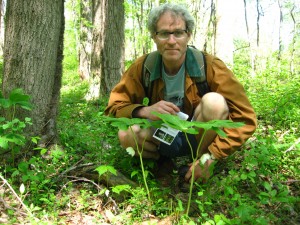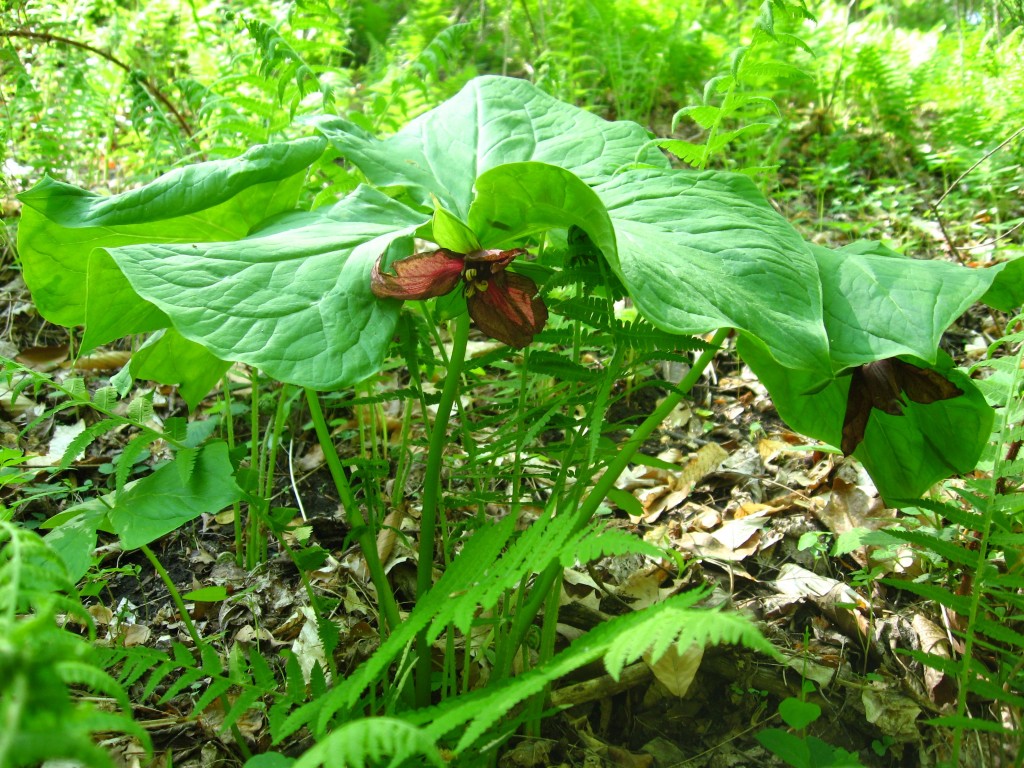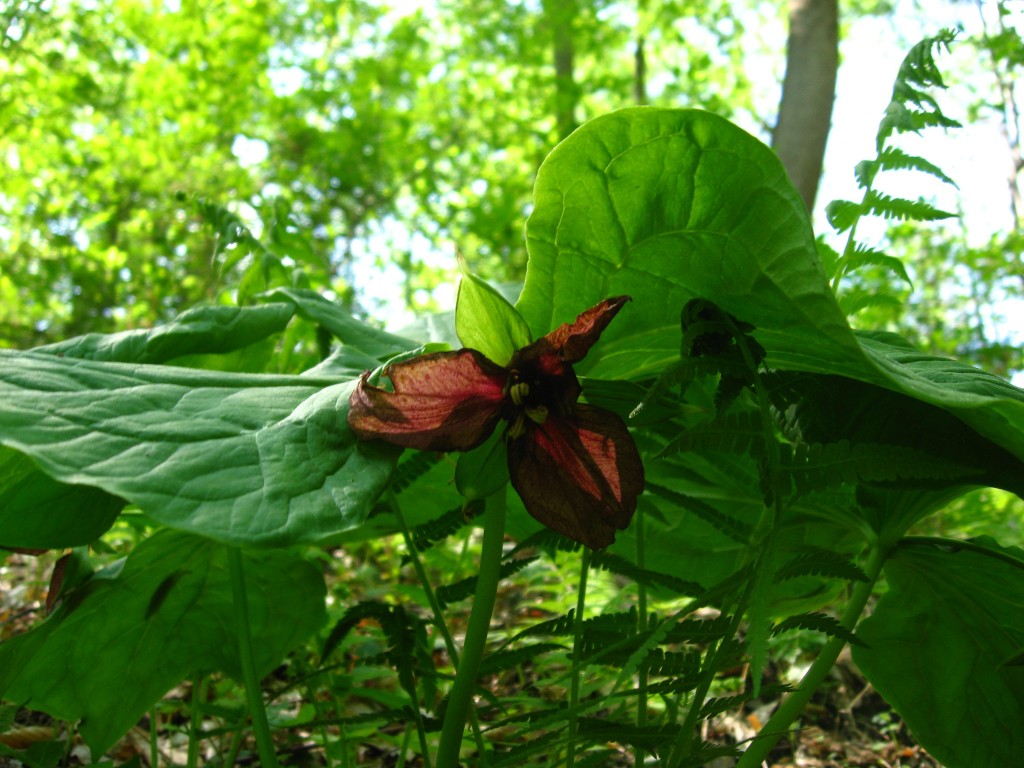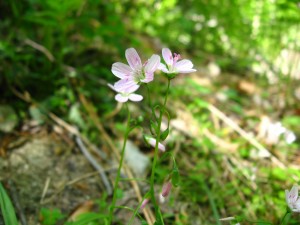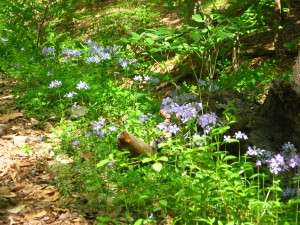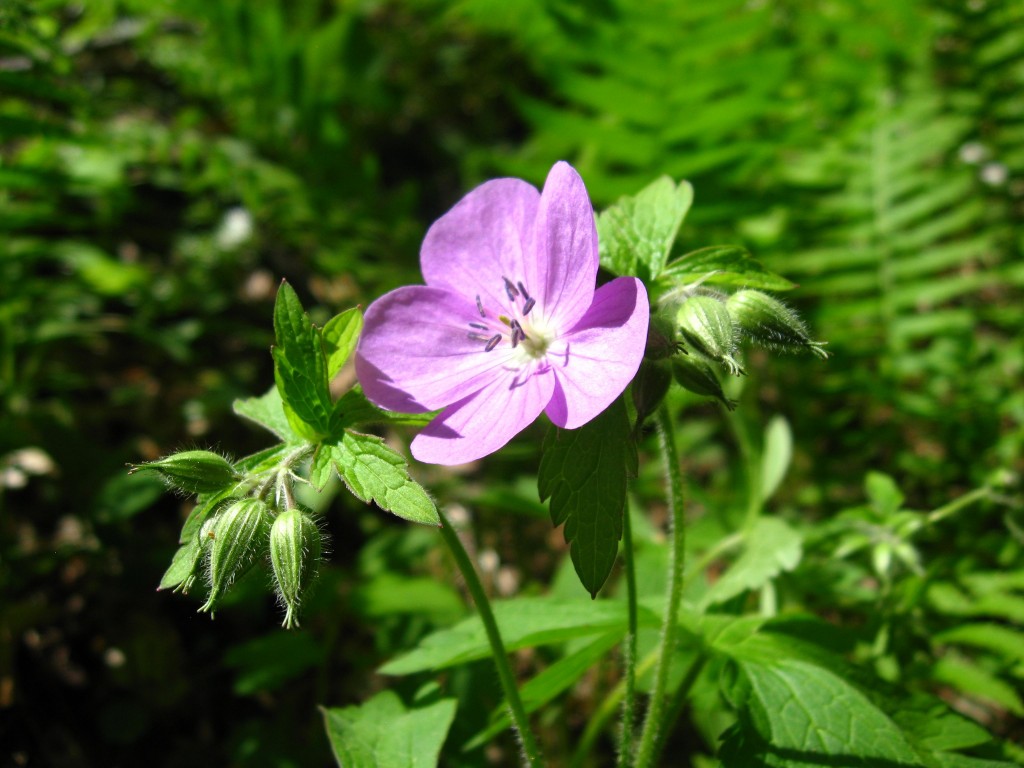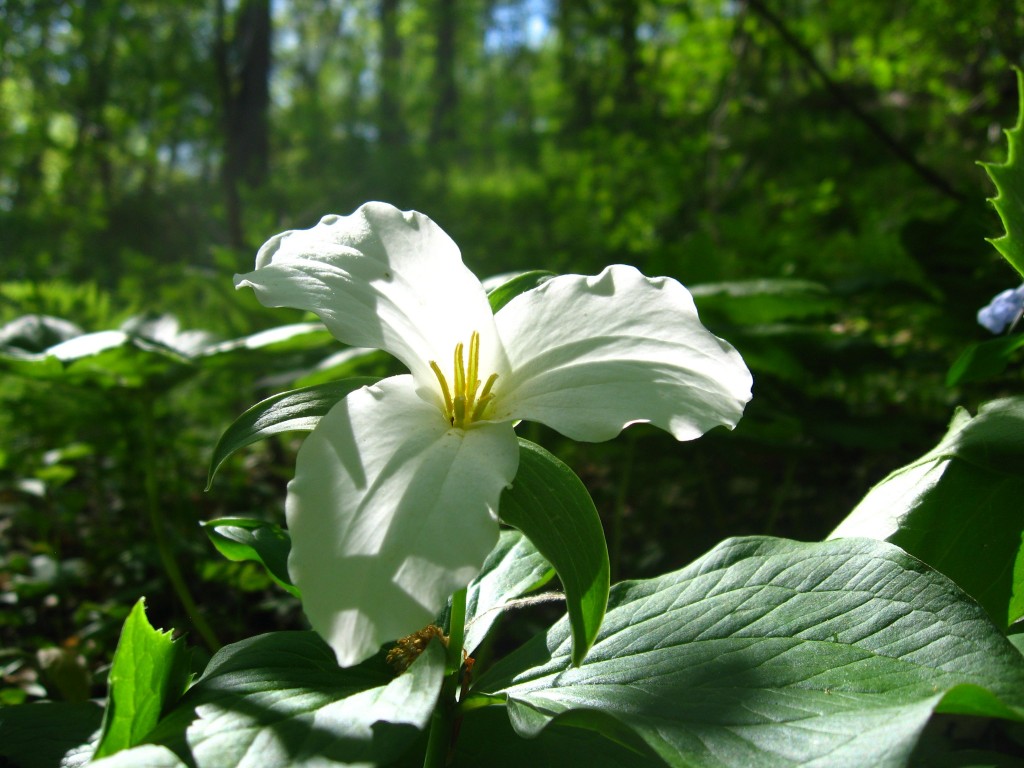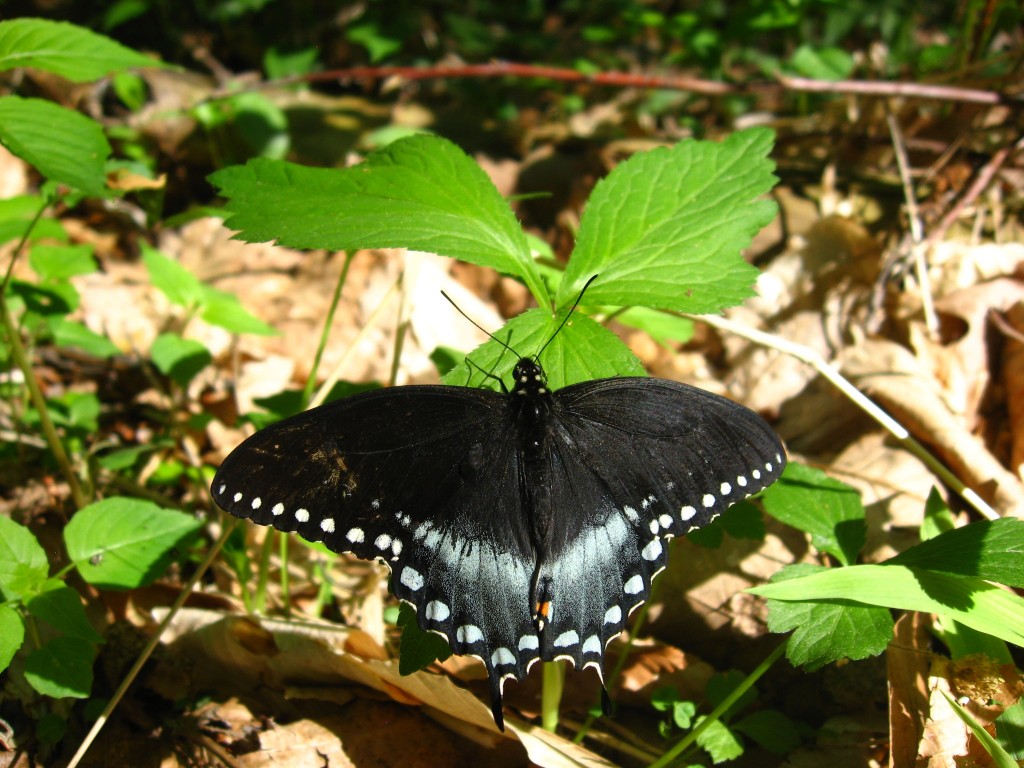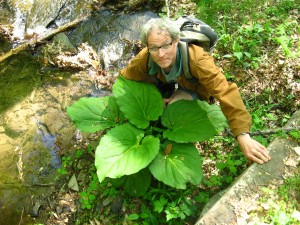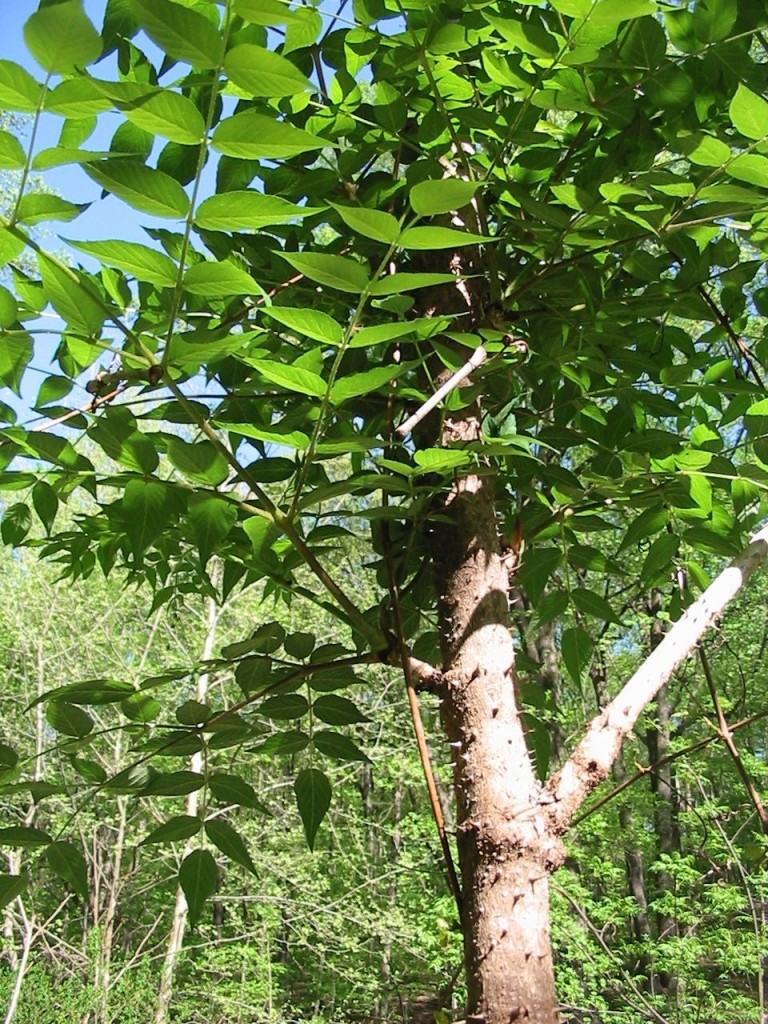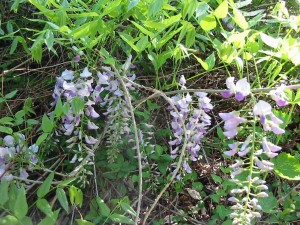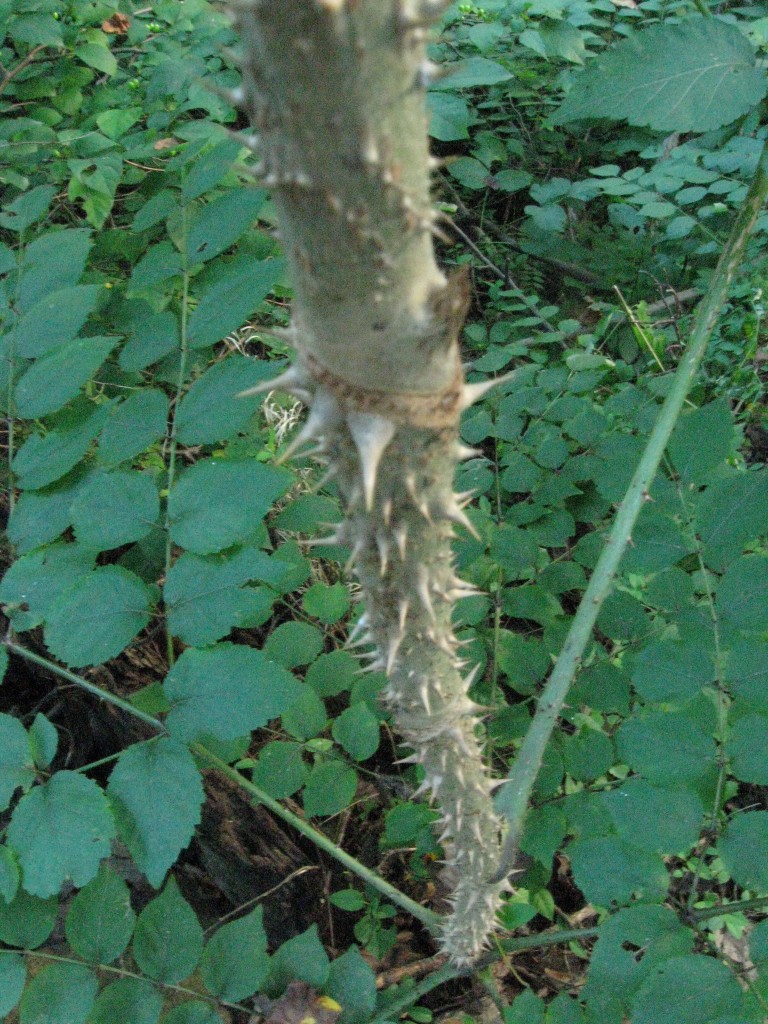
This tree is found throughout Philadelphia, in Fairmount Park, in alleys and neighborhoods. It has a silvery thorny trunk and  produces a striking crown of white to pink flowers in August.  The most dense stands can be found in The Wissahickon Valley Park, but it is also found in abundance in West Fairmount Park, in such locations as the Horticultural Center and along Chamounix  Drive.  In Morris Park it is spreading rapidly, where multiple stands of seed producing specimens have been identified.
The Japanese Angelica Tree is an emerging invasive in the region, and where it has become established there has been a drastic change and disruption to the natural environment. This tree creates a canopy of shade so dense and a root system so interconnected that native trees, shrubs and herbaceous plants are left to die in the wake of this aggressive alien species. Â With the loss of these plants, which have grown here for thousands and millions of years, is a loss of a complex web of habitat that sustains the life of the forest. Â The insects whose patterns of sustenance, such as food and reproduction, are species-specifically dependent, lose their habitat and become locally extirpated with each infestation of the Japanese Angelica Tree. Birds that need insects for survival, will also be displaced as there is no food. When a species has evolved over the millions of years, it does so in a system of species and interactions, often with multiple variables. Â When an introduced species comes into a system, it has the potential to radically change the variables of the system. Â For example, the Japanese Angelica Tree has the ability to block sunlight, which is one variable to a natural system that has an immense effect. It is like a dark cloud that moves over a community of plants, an invading force, permanently shading the area through the entire growing season, and on top of that running a dense network of roots all through the soil that absorbs the moisture and nutrients that will no longer be available to the original community of plants. This is enough to kill off many species of plants and their species-specific insect dependents, and this amounts to localized extirpation, the elimination of a species from its host habitat.
There is nothing to stop these invasions. Acre after acre of Philadelphia’s Fairmount Park system has fallen victim to this species.
This is where our story begins.
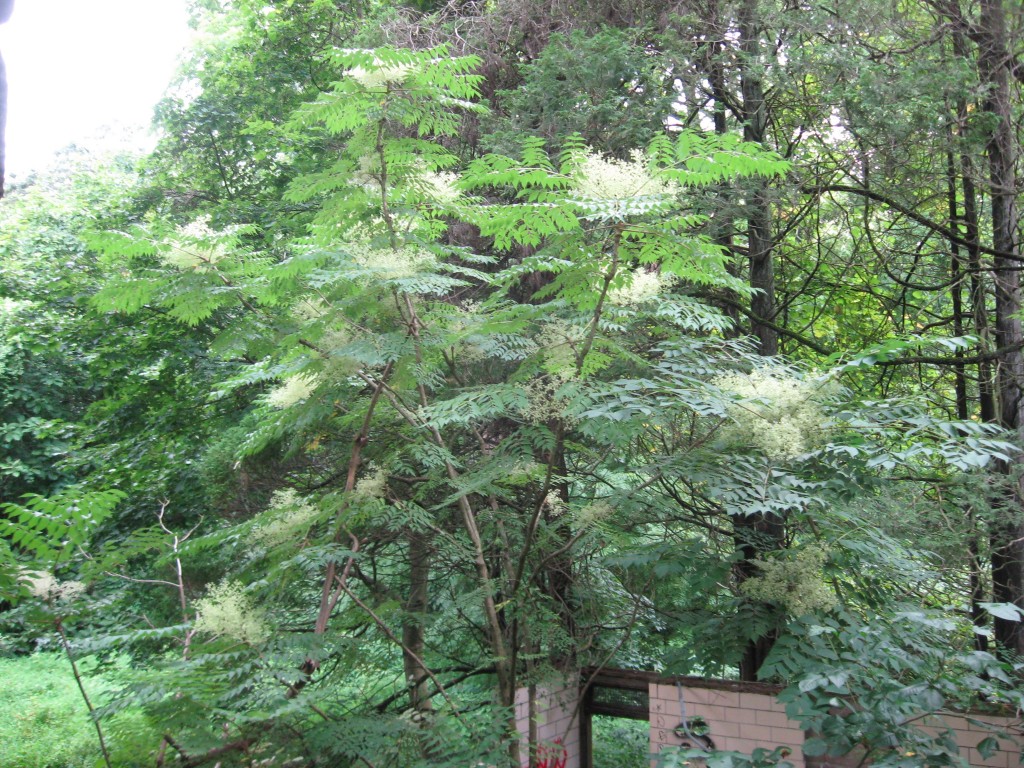
Take a walk through the Wissahickon Valley Park and the Japanese Angelica Tree is everywhere. In the late summer, the white inflorescence  crests the landscape and the spiny trunks line the trails.
Making matters more confusing is that there is a native tree that is very similar to the Japanese Angelica Tree (Aralia elata), called the Devils Walking Stick (Aralia spinosa), which does not grow in the Philadelphia region, but does grow naturally in Western Pennsylvania as well as parts of New Jersey, Delaware and much of the Eastern U.S.
The two species are related. The native one, in its natural range, is part of the natural system, while the exotic one has become a noxious pest.
For a while we thought the Japanese Angelica Tree was the native Devil’s Walking Stick. What we did not know was that even if it was the native tree, we were not in the natural range for the American Arialia spinosa. So even if it was the native Devils walking stick, it would still be out of its range in Philadelphia and therefore out of place. Â We have learned that even ‘native’ plants still have this range, which varies throughout the country plant by plant, and if the plant is outside its historical, evolutionary range, than it is an alien.
We do not know what to expect from aliens. Usually it is something bad or out of the usual order. With plants, this is the case for many specimens that are introduced from other regions. They can take over and create problems. Insects such as the Japanese beetle (Popillia japonica) and now the stinkbug (Halyomorpha halys) are prime examples of alien species.
When examining native range maps of the many indigenous North American Plant species, as presented by the U.S. Geological Survey, there is to be found an intriguing world of plant species and their localized areas. The United States is divided up into a complex and entirely different world than what we generally perceive it to be; there is an astounding geographic dimension to the U.S. that  encompasses thousands of species, with real borders, completely different than those of states, counties and provinces. It is as if there are whole worlds of speciation and  delineation that we are for the most part completely unaware of!
We had no idea that in the Middle of Pennslvania there is a line where the native Devil’s Walking Stick’s range comes to a natural end. Â And between this borderline and the infestations of the Devil’s Walking Stick’s genetic relative, The Japanese Angelica Tree in Morris Park is where our adventure starts out.
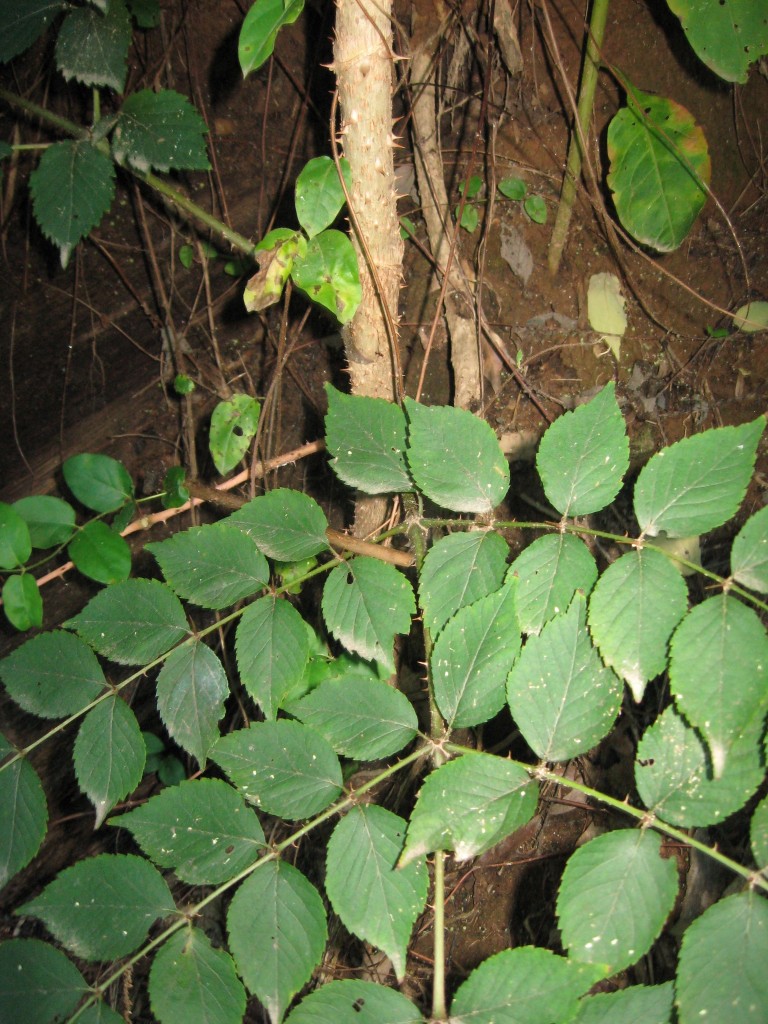
We had always admired the binnately compound leaf of the Japanese Angelica tree, as illustrated above. What is pictured is one leaf, composed of a series of branches holding leaflets, in sets of two along each branch.
The Philadelphia Parks and Recreation Staff, technician Luke Rhodes and Land Steward Thomas Dougherty alerted us to the designation of the species, the invasive Aralia elata, the Japanese Angelica Tree. After double checking this information out, our next question was what can we do about it? Â We tried to chop them down, but the extensive root systems would send up new shoots.
Tom And Luke of Fairmount Park saw that Isabelle and I were serious about trying to eradicate this invasive, and we formed a partnership, and the eradication process had begun. Â The Philadelphia Parks and Recreation Staff tasked us volunteers with mapping the infestations and identifying target areas for eradication. Â We chose sites that were the closest to forest areas that had the least invasives and the highest diversity of native flora. Â Tom and Luke then applied the herbicide Garlon 4 ultra with a green dye ( to help identify applied specimens) in a basal bark application to the mature seed-producing specimens in a first pass attempt at eradication.
Japanese Angelica Tree, Aralia elata, Morris Park , Philadelphia, Pennsylvania
The process started: The mature specimens were treated with herbicide in the late winter, and they died by May or June. Above, the herbicide is applied around the bark at the base of the tree leading to the technical jargon basal bark herbicide application.
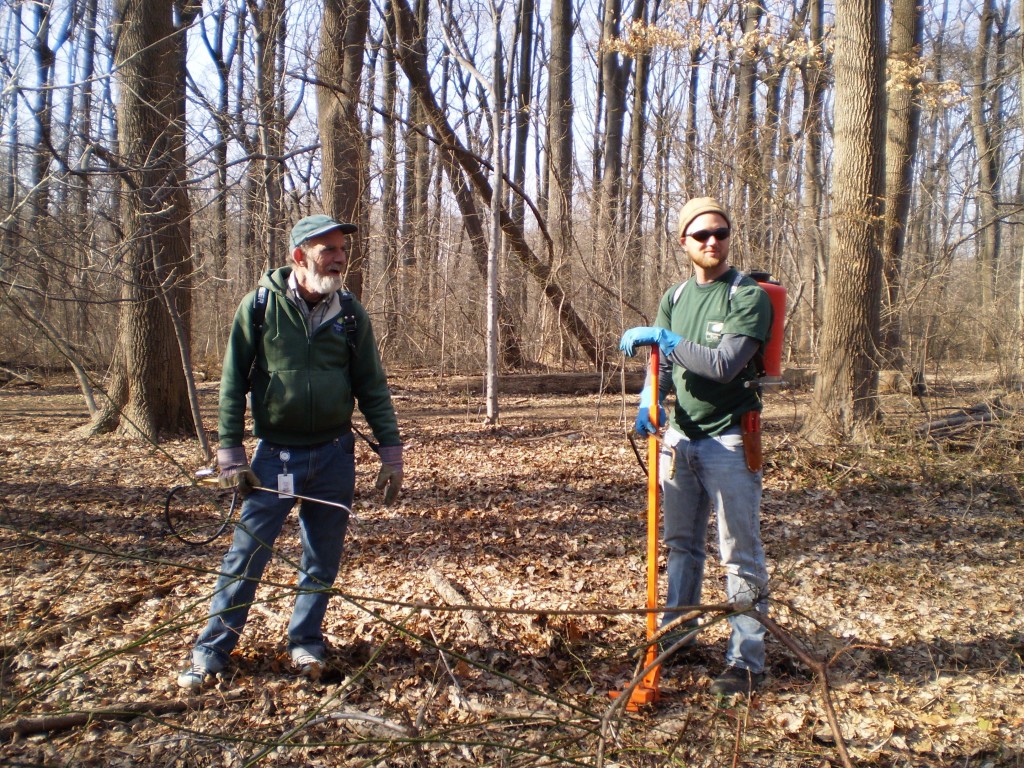
Tom and Luke take a quick break. Luke is resting on a weed wrench, a tool that we volunteers were using to remove another invasive, the Burning Bush, the euonymus alatus.
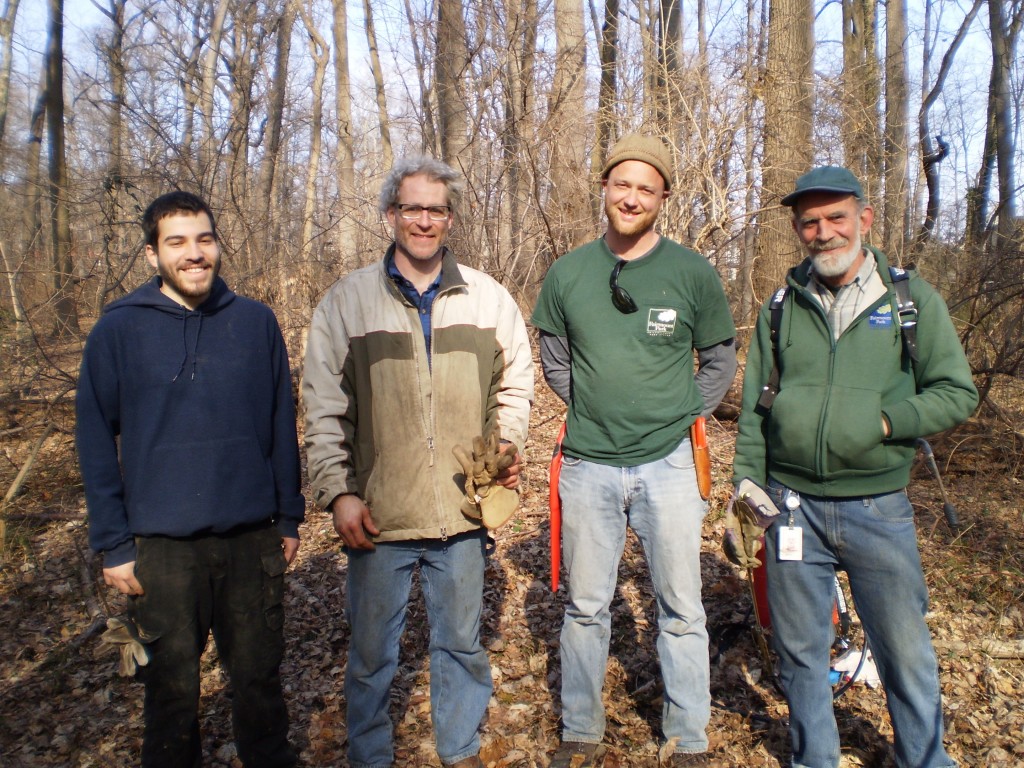
Isabelle cracked a good joke to get us all to smile: From left: Jason Puglionesi, Sean Solomon, Luke Rhodes, Tom Dougherty.
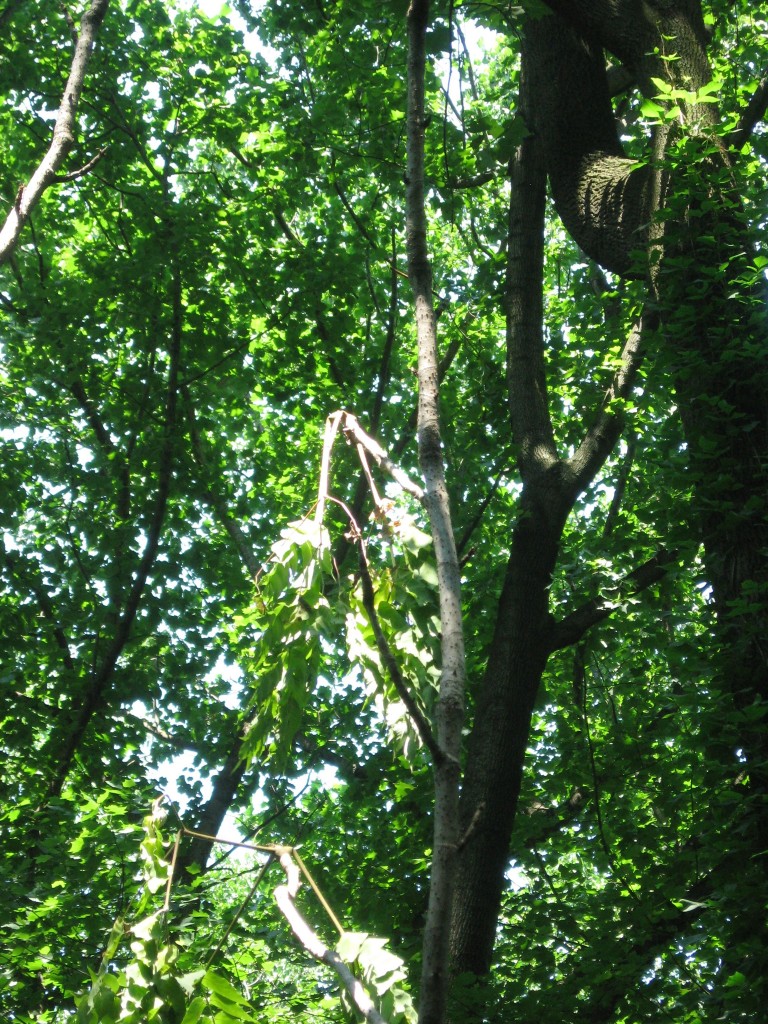
Fast forward to late Spring 2012, and the treated specimens have leafed out, only to begin dying off soon after.
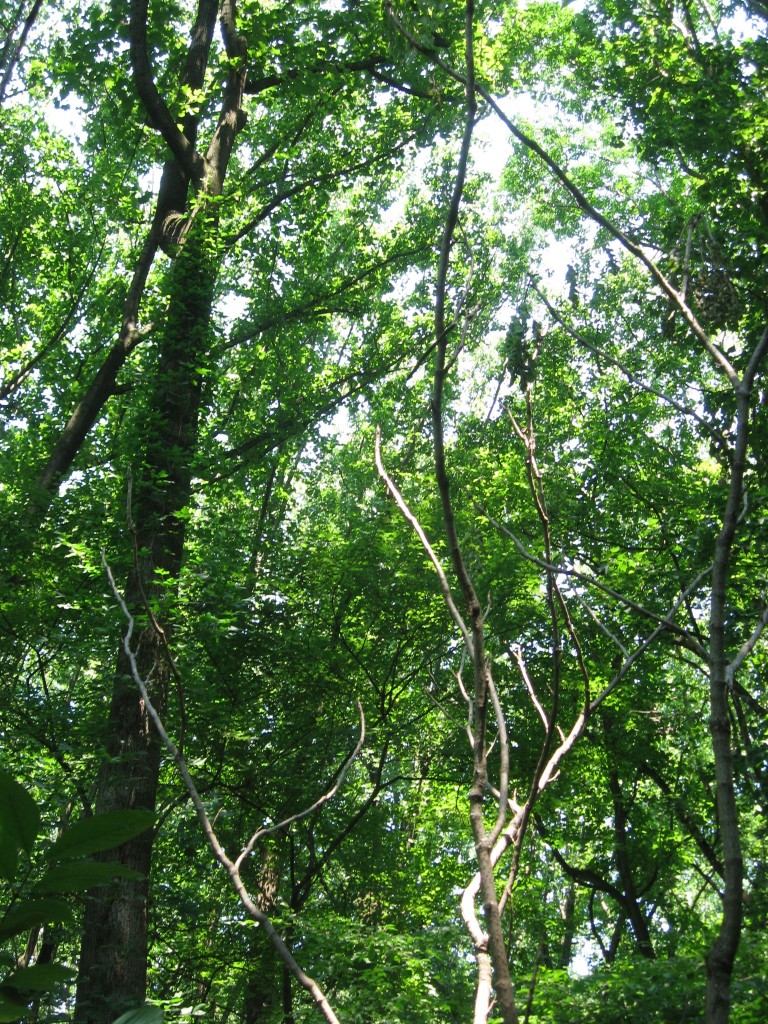
By summer, the trees are completely dead.
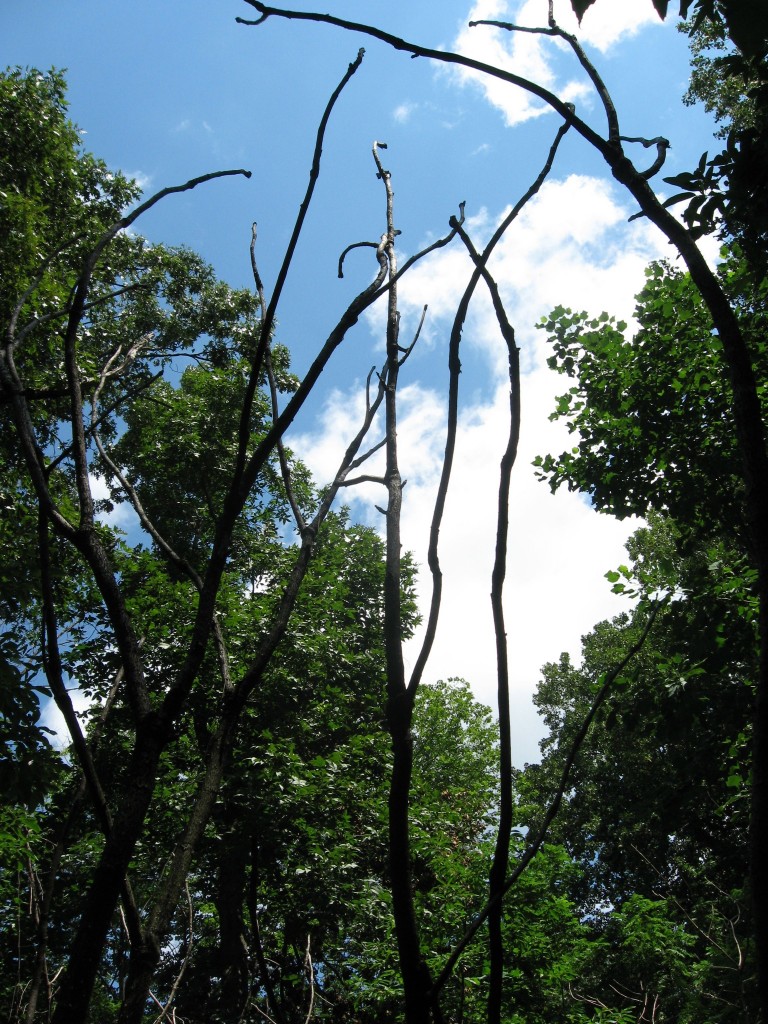
This is last year’s batch, treated in February of 2011, they are apparitions at this point, the whole stand has been crashing to the ground one by one.
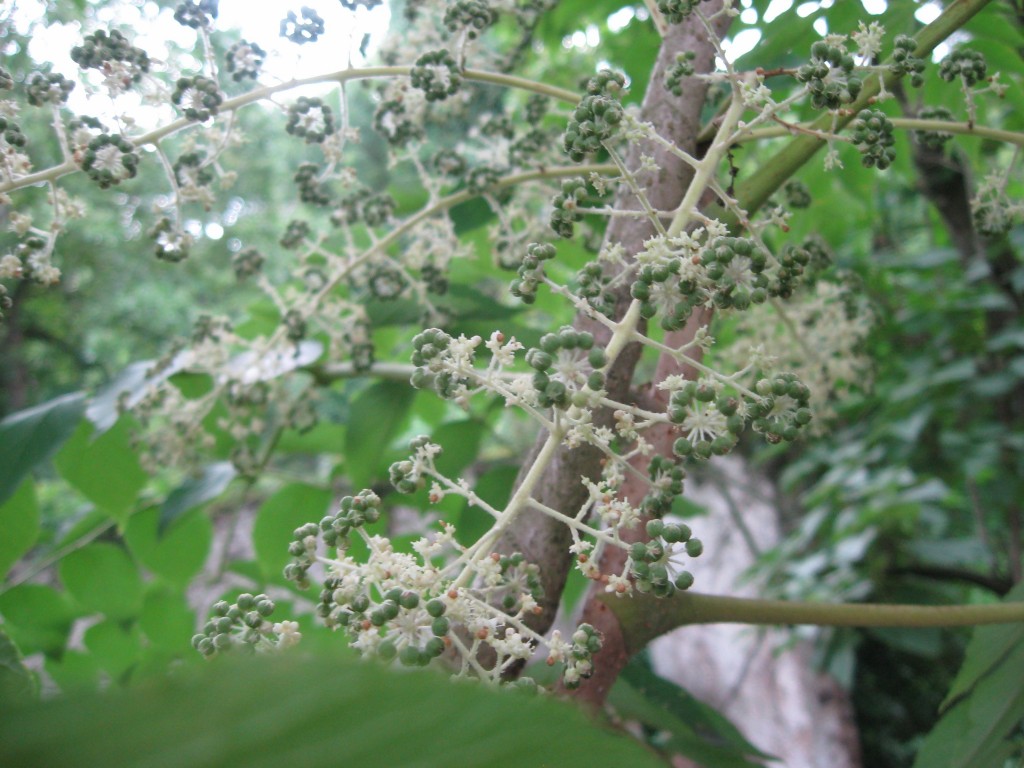
Here is a closer look at the fruits of the Angelica Tree, found in early August on a dense stand in The Wissahickon, in the Creshiem Valley section. Each tree produces hundreds of seeds on display in multiple circular clusters. The ripe seeds attract birds, who end up helping the plant spread its range rapidly. The irony is that while the birds get instant gratification from the berries, their spread is actually destroying habitats of other plants the birds depend on in the long term.
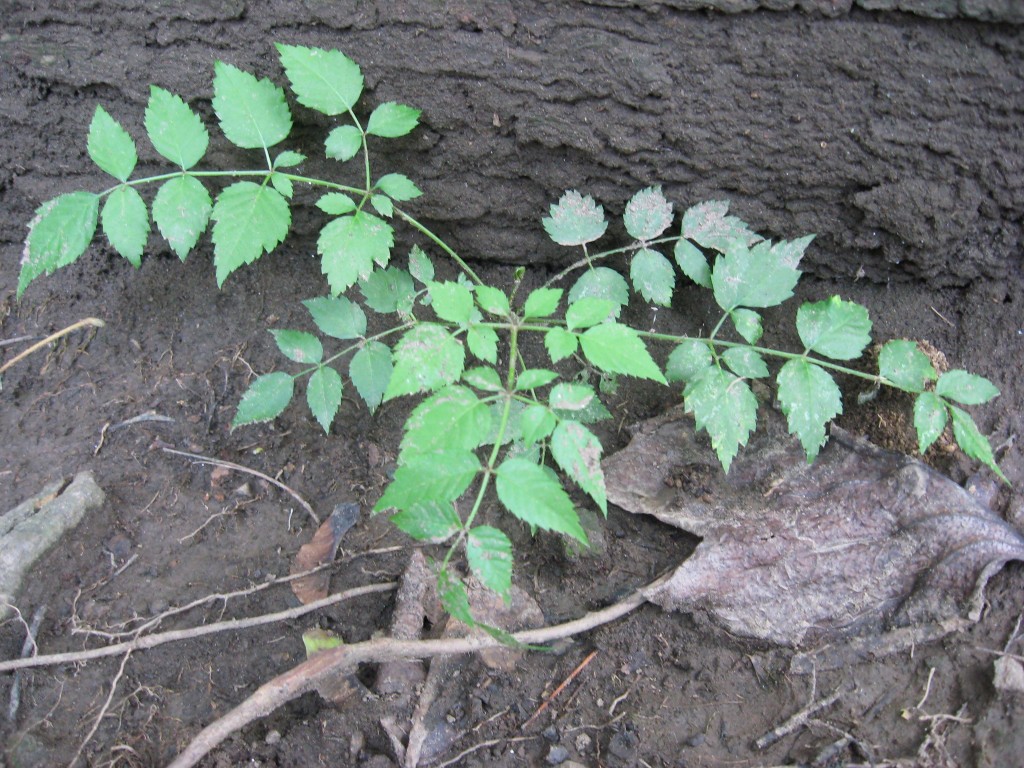
Here is a seedling right next to our house, in an area where there had been no mature seed-producing specimens in the immediate vicinity. The seedlings number in the hundreds, and we have to hand pull each and every one. This seedling can grow up to three feet tall in one growing season. Â In the areas where the seed-producing mature specimens have been eradicated, the now sunlit forest floor has erupted in a mass of seedlings so dense they number in the thousands. Many native plants and trees are among this startling infestation of noxious weeds, which necessitates hand pulling.
A daunting task to initiate!
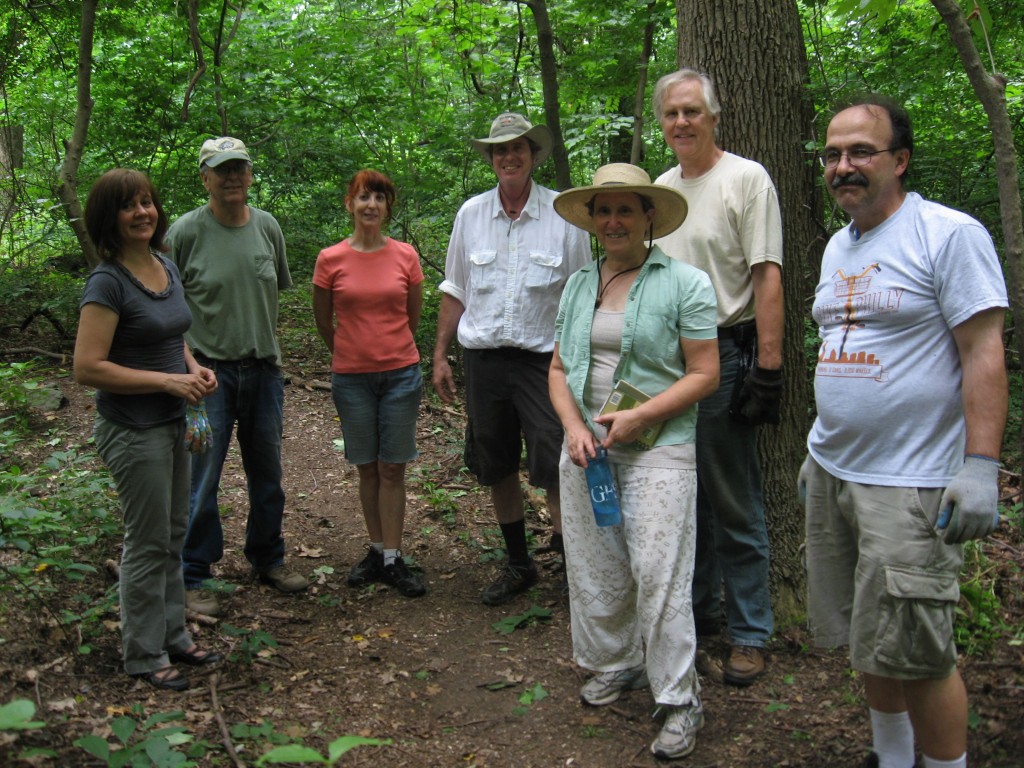
Meet the Friends of Haverford Trails- they are a neighboring Park Friends group working on an area that is part of the Cobbs Creek watershed. They came out to visit our site in July and were glad to lend a helping hand with our Aralia elata problem.
From left after Isabelle: Barry Pinheiro, Frances Heron, Joe Walker, Jane Horwitz, Roy Sandstrom and Peter Puglionesi.
We were able to pull a whole infestation of seedlings in a half hour! We spent the rest of the time touring the site and talking about native plants and trees as well as our volunteer projects.
We use thick gloves with those spiny stems. Â The pulled specimens are scattered about the site, where they will die and return to organic matter, hopefully to be used by a native plant of local provenance.
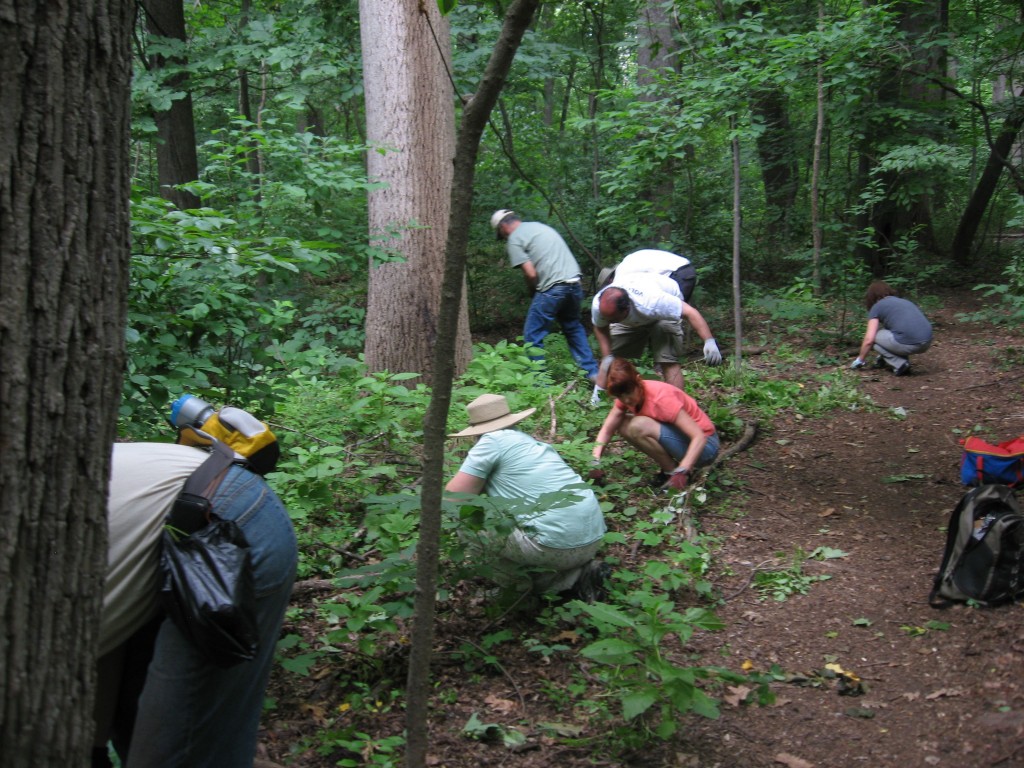
We discovered Jack-in- The Pulpit, Joe-Pye-Weed, White oak seedlings, Sassafrass and Dogwood in the area we worked on.
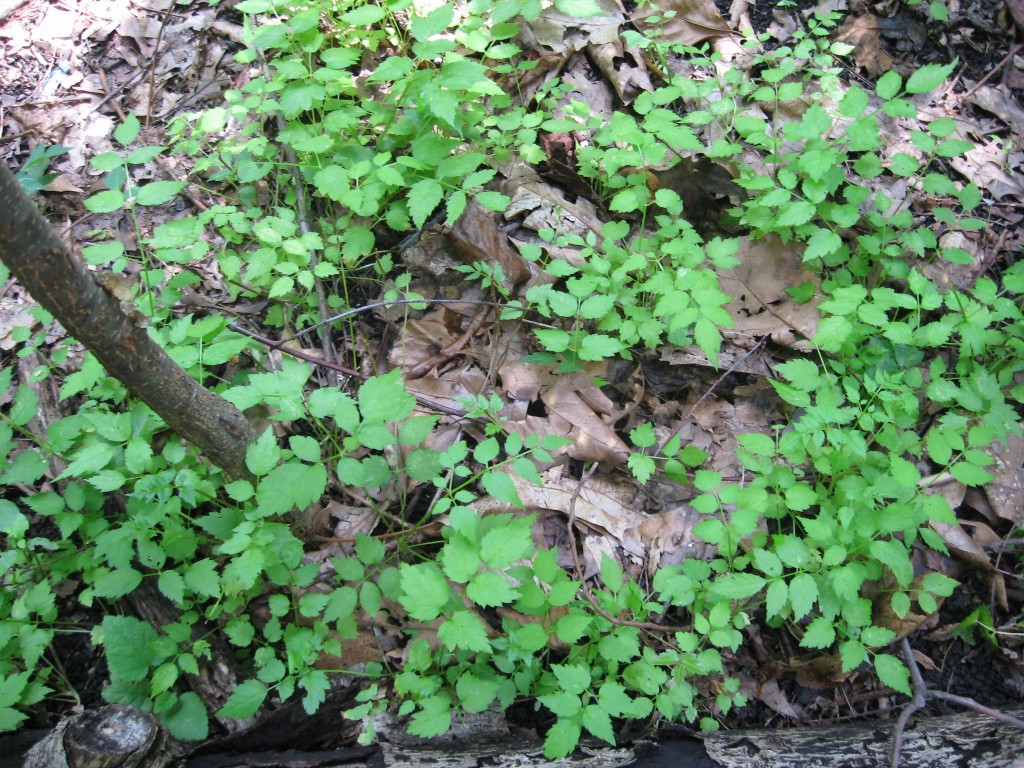
Mass of Seedlings.
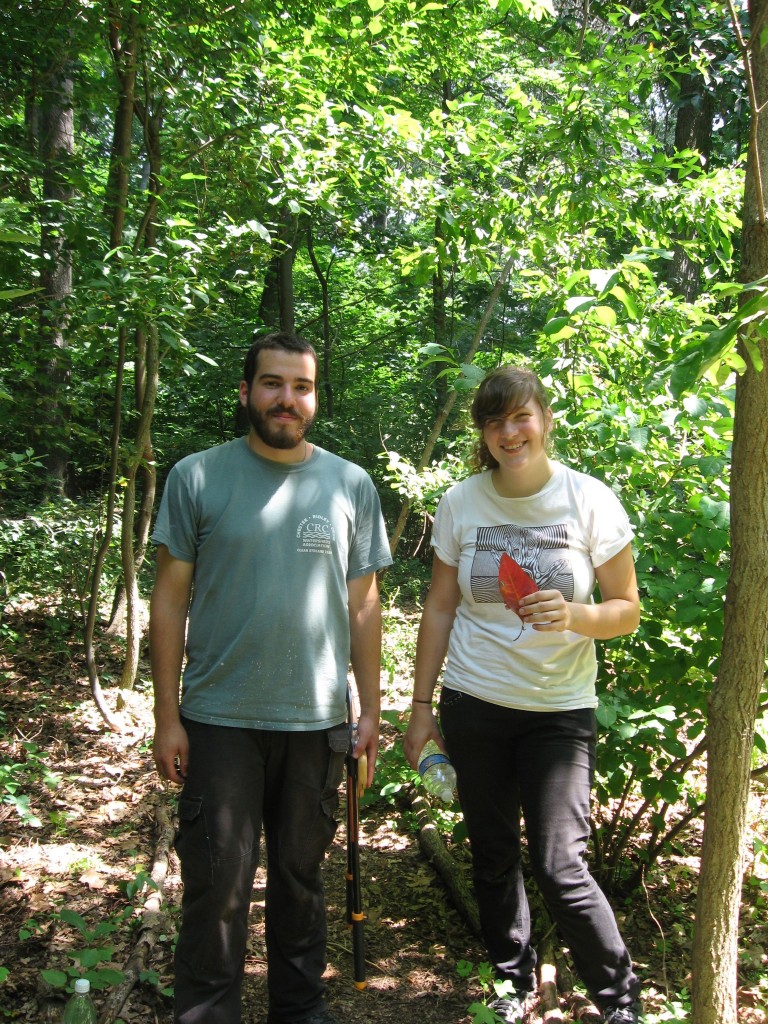
Our friend Jason whom you have met from our Garlic Mustard adventures of 2012, Â and his friend Skylar came out on August 2nd to help out as well, and we pulled seedlings for a short afternoon. We also pulled the invasive Japanese Stiltgrass along the trails. Skylar is holding a red Hickory leaf. Just the slightest hint of Fall in the air, eh?
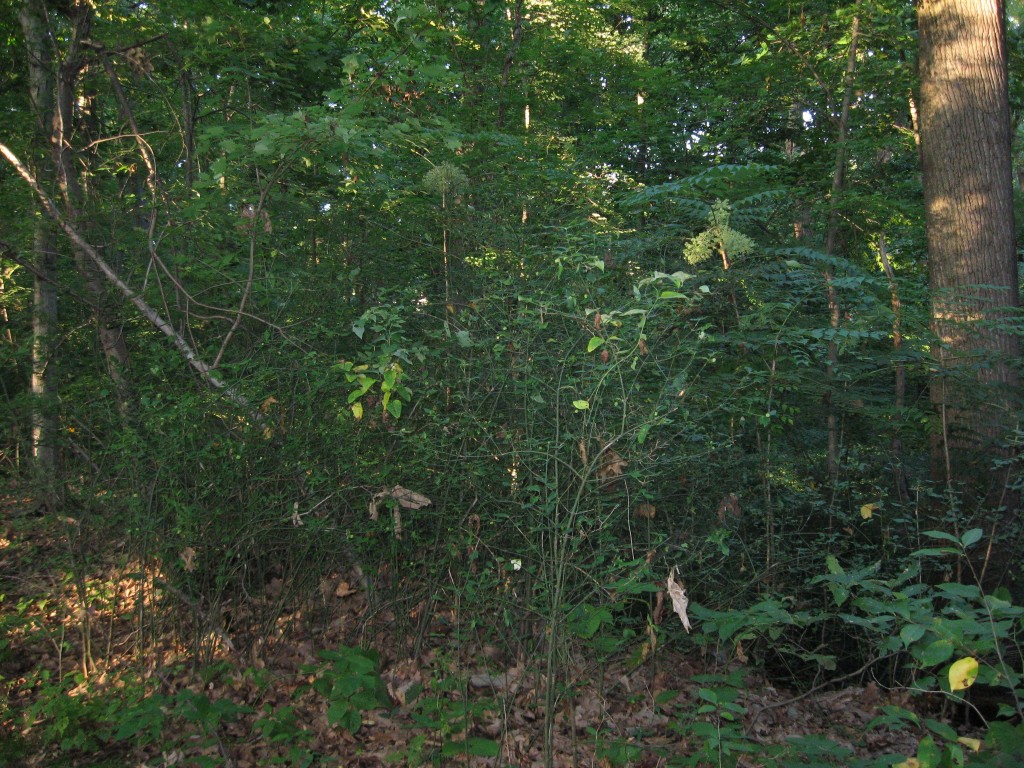
Last but not least, is a site of great interest in Fairmount Park, this is just a few yards north of Mom Rinker’s Rock, where the Toleration Statue is located.  Besides the lovely views and colorful history, this is a site of huge importance to us because growing there is the native shrub Hearts-A-bustin’, the Strawberry bush, the Euonymus americana, a beautiful and elegant shrub that has been passed over by the horticultural industry  in favor of the previously mentioned Burning bush, the invasive and noxious introduced but closely related shrub, Euonymus alatus, which has infested many areas of the Wissahickon as well as Morris Park. In fact the Euonymus alatus is found growing side by side with the native Euonymus americana, the Hearts-a-Bustin’.
Even more disturbing is that the Hearts-a-Bustin’ is being encroached upon by an infestation of  an aggressive  stand of the Japanese Angelica Tree!  In all of our adventures through the Fairmount Park System, we have never seen the Hearts-a-Bustin’, except at this one unusual site, and yet this special area is threatened by this same invasive as found throughout the park. A few good workdays the way we have been doing it could really help out this little place, where do we sign up?
Lessons learned: Nothing is as easy as we think it might be. Cannot underestimate a loaded seedbank.
While Humans have certainly created many conditions that are leading to environmental disfunction, habitat loss and species extirpation and extinction, there are some things we can do, and have fun doing them.
Traveling to nearby areas helps one learn more about your own area. In fact traveling and exploring is a great educational experience, and you will bring home a great perspective and knowledge.
A species outside its natural range has the potential to be a dangerous species: when considering plants it is all about the location, the provenance. A species will do everything it can to propagate, as it is programmed to do. When outside of its evolutionary system, it can become an unchecked variable, creating disorder to habitats that are not in any way evolved to absorb such a disturbance, requiring us humans to make ourselves useful and intervene.
